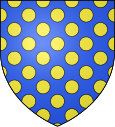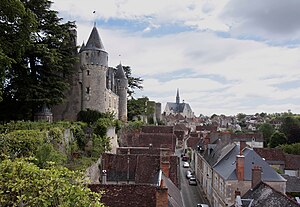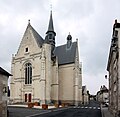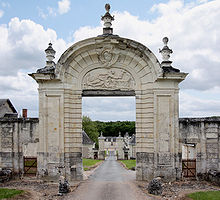Montrésor
| Montrésor | ||
|---|---|---|

|
|
|
| region | Center-Val de Loire | |
| Department | Indre-et-Loire | |
| Arrondissement | Loches | |
| Canton | Loches | |
| Community association | Loches Sud Touraine | |
| Coordinates | 47 ° 9 ' N , 1 ° 12' E | |
| height | 87-121 m | |
| surface | 0.98 km 2 | |
| Residents | 341 (January 1, 2017) | |
| Population density | 348 inhabitants / km 2 | |
| Post Code | 37460 | |
| INSEE code | 37157 | |
 View over the village towards the parish church |
||
Montrésor is a French municipality with 341 inhabitants (at January 1, 2017) in Indre-et-Loire in the region of Center-Val de Loire ; it belongs to the Arrondissement of Loches and the Canton of Loches . The place is in the southeast of the Touraine , about 16 kilometers from Loches , in the valley of the river Indrois .
With an area of just 98 hectares, Montrésor is one of the smallest towns in the department.
history
The village, like many others, has its origins in a castle built in the 11th century by Fulko Nerra , Count of Anjou . Some remains of the donjon from the 12th century with its surrounding wall have been preserved from this complex . Today's Montrésor Castle was built by the then heir of Montresor, Imbert de Bastarnay , at the beginning of the 16th century, as well as a collegiate church (today a parish church ), which is one of the most important religious buildings of the Renaissance in France.
In 1849 the castle came into the possession of Count Xavier Branicki , a Polish emigrant who killed Napoleon III in the Crimean War . to Constantinople . He had the dilapidated castle completely restored and refurbished. His descendants still live there today.
The place and the castle, which looks down from a rocky ledge, have an attractive location on the banks of the Indre . For this, Montrésor was accepted into the association “Les plus beaux villages de France” ( The most beautiful villages in France ). Also worth seeing are an old wash house on the river, the market hall La Halle des Cardeux from 1700, whose name recalls the time of the flourishing textile trade (→ carding ), and the Logis du Chancelier (today mayor's office) from 1581.
Population development
| year | 1962 | 1968 | 1975 | 1982 | 1990 | 1999 | 2004 |
|---|---|---|---|---|---|---|---|
| Residents | 522 | 506 | 465 | 460 | 362 | 395 | 384 |
Parish Church of Saint-Jean-Baptiste
Imbert de Bastarnay had the former collegiate church started in 1519 while the castle was being built. The building, which was finally completed in 1541, has a single nave and a cross-shaped floor plan. The architectural style is late Gothic with a 5/8 choir, ribbed vaults and tracery windows in the flamboyant style. The appearance derives its Renaissance character from the decorative shapes. In this regard, the entrance front is a remarkable work of this style epoch in France.
The church was built as a grave church, because Bastarnay's tomb should be in the center of the church choir . Destroyed in the French Revolution , restored in 1875, it finally found its present place in the rear part of the nave . The tomb consists of three marble reclining figures, the lord of the castle, his wife and his son, who rest on a slab with the statues of the 12 apostles attached to the base under arcades . The work is attributed to the Renaissance sculptor Jean Goujon , although the quality of the work has suffered greatly from the many necessary additions made with plaster of paris.
In addition to the tomb, the choir stalls decorated with medallions and misericords from the 16th century have been preserved, and two windows date from the same period. One of the paintings that stands out is a 17th century “Annunciation” by the Flemish painter Philippe de Champaigne .
Chartreuse Saint-Jean du Liget
Not far from Montrésor, in Chemillé-sur-Indrois , are the ruins of the former Carthusian monastery of Chartreuse Saint-Jean du Liget (1170–1791). It was founded by the English King Henry II. According to an inscription previously placed above the entrance to the Charterhouse , the king wanted to atone for the murder of his Chancellor Thomas Becket , Archbishop of Canterbury, which he had instigated .
Today only the ruins of the monastery church on the extensive grounds remind of the time of the foundation in the 12th century. The surviving parts, the gate, a wing of the large cloister and the farm buildings date mainly from the 18th century.
The Saint-Jean chapel is very close to the Charterhouse . It is a small, unusual rotunda made of white ashlar stones, with arched windows, a cornice that cranks around the windows, an arched frieze and a low conical roof. It is probably the first monastery chapel in the town from the second half of the 12th century. The special thing about the externally unadorned building are the Romanesque frescoes preserved inside.
Personalities
- Imbert de Bastarnay (1438–1523), lord of Montrésor
- Claude de Bourdeille (1606–1663), Lord of Montrésor
- Xavier Branicki (1816–1879)
- Moreau de Tours (1804-1884), doctor and psychiatrist
- Roger Moreau (1945–1977), Mayor of Montrésor
literature
- Le Patrimoine des Communes d'Indre-et-Loire. Flohic Editions, Volume 2, Paris 2001, ISBN 2-84234-115-5 , pp. 991-997.






